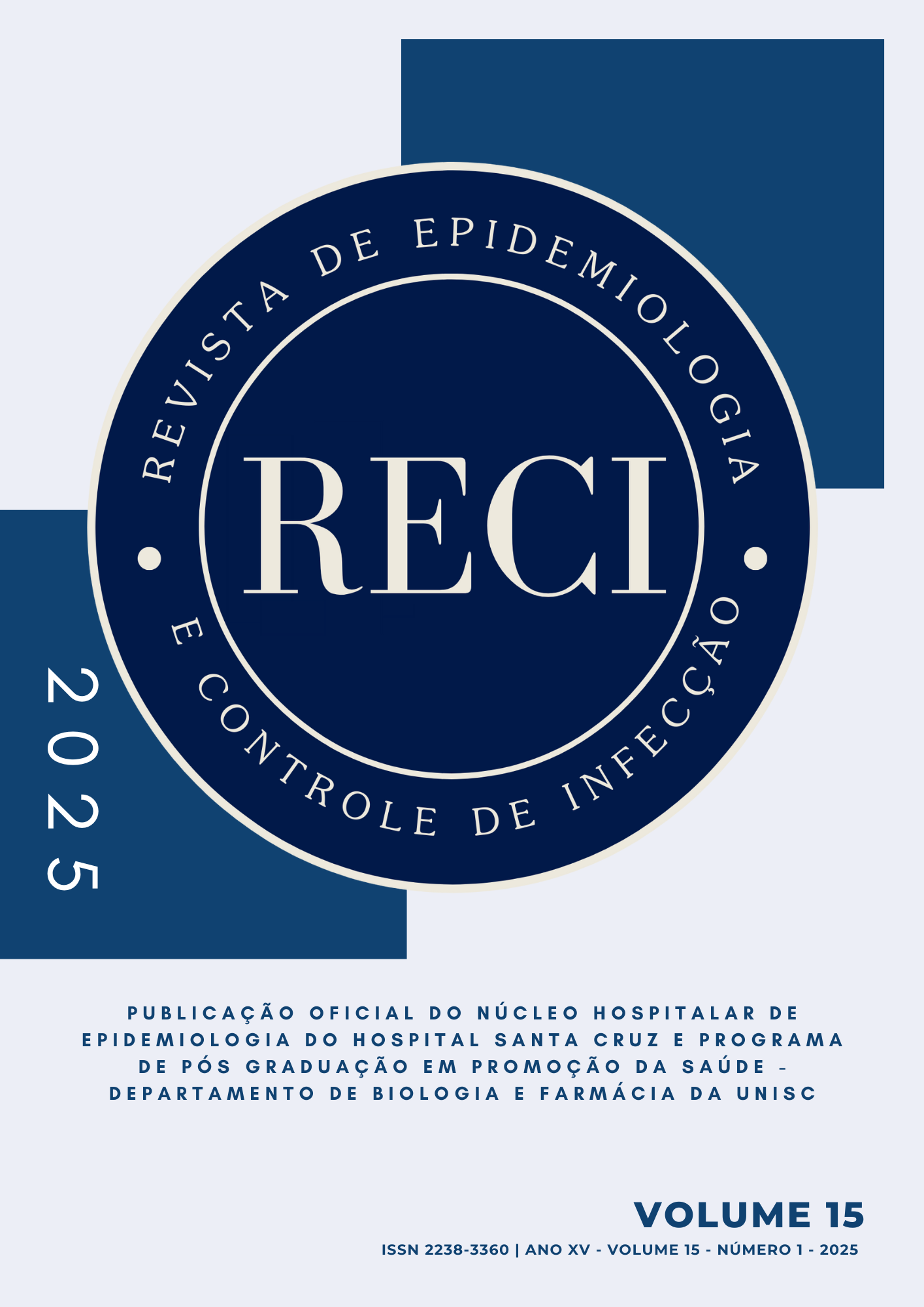Impact of the use of macrolide antibiotics on bacterial resistance in non-fibrocystic bronchiectasis: a systematic review
DOI:
https://doi.org/10.17058/reci.v15i1.19905Abstract
Background and Objectives: bronchiectasis is a chronic respiratory disease characterized by irreversible bronchial wall dilation, mucociliary dysfunction, persistent cough, productive sputum and recurrent infections. The use of antibiotics is an essential part of the treatment of non-cystic fibrosis bronchiectasis, with macrolides being commonly used due to their anti-inflammatory properties and effectiveness in neutrophilic diseases. However, the frequent use of macrolides is concerning due to their potential to induce antimicrobial resistance. In this regard, this article assessed the impact of macrolide antibiotic therapy in non-cystic fibrosis bronchiectasis on the emergence of bacterial resistance. Methods: this is a descriptive systematic review, carried out in the PubMed, LILACS and SciELO databases, including all articles published until August 2020 that were available in Portuguese, English and/or Spanish, using the keywords “antimicrobial resistance” and “bronchiectasis”. On the other hand, reviews, opinion articles and editorials were excluded as well as those works that did not investigate bacterial resistance, especially to macrolide antibiotics. Results: the review found five studies, all carried out between 2008 and 2016 in Australia, New Zealand and the Netherlands, that assessed the effects of macrolides in children and adults with bronchiectasis. Four were controlled clinical trials and one was a prospective cohort study. Although studies have shown that macrolides were effective in reducing exacerbations and improving lung function, they have also reported the development of macrolide resistance in some cases. This article emphasizes the need for cautious use of macrolides in the treatment of bronchiectasis unrelated to cystic fibrosis due to the potential for antimicrobial resistance.
Downloads
References
Laska IF, Crichton ML, Shoemark A, et al. The efficacy and safety of inhaled antibiotics for the treatment of bronchiectasis in adults: a systematic review and meta-analysis. Lancet Respir Med. 2019;7(10). https://doi.org/10.1016/S2213-2600(19)30185-7
Martins KB, Olmedo DWV, Paz MM, et al. Staphylococcus aureus and its Effects on the Prognosis of Bronchiectasis. Microb Drug Resist. 2021;27(6):823–34. https://doi.org/10.1089/mdr.2020.0352
Pereira MC, Athanazio RA, Roth Dalcin P de T, et al. Consenso brasileiro sobre bronquiectasias não fibrocísticas. J Bras Pneumol. 2019;45(4):e20190122. http://doi.rg/10.1590/1806-3713/e20190122
Yates B, Ahmad T, Doherty M, Watson G. Bronchiectasis. Am J Respir Crit Care Med. 2015;192(7):859-860. https://doi.org/10.1164/rccm.201507-1449LE
Kelly C, Chalmers JD, Crossingham I, Relph N, Felix LM, Evans DJ, Milan SJ, Spencer S, Cochrane Airways Group. Macrolide antibiotics for bronchiectasis. Cochrane Database Syst Rev. 2018; (3). https://doi.org/10.1002/14651858.CD012406.pub2
Gaynor M, Mankin AS. Macrolide Antibiotics: Binding Site, Mechanism of Action, Resistance. Curr. Top. Med. Chem. 2003; 3 (9), 949-961. https://doi.org/10.2174/1568026033452159
Wang D, Fu W, Dai J. Meta-analysis of macrolide maintenance therapy for prevention of disease exacerbations in patients with noncystic fibrosis bronchiectasis. Med (United States). 2019;98(17): e15285. http://doi.org/10.1097/MD.0000000000015285
Ghosh S, Bornman C, Zafer MM. Antimicrobial Resistance Threats in the emerging COVID-19 pandemic: Where do we stand? J. Infec. Public Health. 2021; 14(5):555-560. https://doi.org/10.1016/j.jiph.2021.02.011
Ferri M, Ranucci E, Romagnoli P, et al. Antimicrobial resistance: A global emerging threat to public health systems. Crit Rev Food Sci Nutr. 2017;57(13):2857-2876. http://doi.org/10.1080/10408398.2015.1077192
Inchingolo R, Pierandrei C, Montemurro G, et al.. Antimicrobial resistance in common respiratory pathogens of chronic bronchiectasis patients: A literature review. Antibiotics. 2021;10(3):326. http://doi.org/10.3390/antibiotics10030326
Serisier DJ, Martin ML, McGuckin MA, et al. Effect of long-term, low-dose erythromycin on pulmonary exacerbations among patients with non-cystic fibrosis bronchiectasis: The BLESS randomized controlled trial. JAMA. 2013;309(12):1260-1267. http://doi.org/10.1001/jama.2013.2290
Altenburg J, De Graaff CS, Stienstra Y, et al. Effect of azithromycin maintenance treatment on infectious exacerbations among patients with non-cystic fibrosis bronchiectasis: The BAT randomized controlled trial. JAMA. 2013;309(12):1251-1259. http://doi.org/10.1001/jama.2013.1937
Valery PC, Morris PS, Byrnes CA, et al. Long-term azithromycin for Indigenous children with non-cystic-fibrosis bronchiectasis or chronic suppurative lung disease (Bronchiectasis Intervention Study): A multicentre, double-blind, randomised controlled trial. Lancet Respir Med. 2013;1(8):610-620. http://doi.org/10.1016/S2213-2600(13)70185-1
Goyal V, Grimwood K, Byrnes CA, et al. Amoxicillin–clavulanate versus azithromycin for respiratory exacerbations in children with bronchiectasis (BEST-2): a multicentre, double-blind, non-inferiority, randomised controlled trial. Lancet. 2018;392(10154):1197-1206. http://doi.org/10.1016/S0140-6736(18)31723-9
Hare KM, Singleton RJ, Grimwood K, et al. Longitudinal Nasopharyngeal Carriage and Antibiotic Resistance of Respiratory Bacteria in Indigenous Australian and Alaska Native Children with Bronchiectasis. PLoS One. 2013;8(8). https://doi.org/10.1371/journal.pone.0070478
Zavala-Flores and Salcedo-Matienzo. Medicación prehospitalaria en pacientes hospitalizados por COVID-19 en un hospital público de Lima-Perú. Acta Med Peru 2020; 37(3):393–395. http://dx.doi.org/10.35663/amp.2020.373.1277
Sultana J, Cutroneo PM, Crisafulli S, et al. Azithromycin in COVID-19 Patients: Pharmacological Mechanism, Clinical Evidence and Prescribing Guidelines. Drug Saf [Internet]. 2020;43(8):691–8. https://doi.org/10.1007/s40264-020-00976-7
Freires MS, Rodrigues Junior OM. Resistência bacteriana pelo uso indiscriminado da azitromicina frente a Covid-19: uma revisão integrativa. Res Soc Dev. 2022;11(1). https://doi.org/10.33448/rsd-v11i1.25035
Athanazio R, Rached S. O uso de macrolídeos para bronquiectasias, Pneumologia Paulista 2016; 29 (1). http://itarget.com.br/newclients/revista-sppt/wp-content/uploads/2016/02/PP01032016.pdf
WORLD HEALTH ORGANIZATION (WHO). WHO report on surveillance of antiotic consumption. https://www.who.int/publications/i/item/who-report-on-surveillance-of-antibiotic-consumption
Murray CJ, Ikuta KS, Sharara F, et al. Global burden of bacterial antimicrobial resistance in 2019: a systematic analysis. Lancet 2022; 399 (10325):629-655. https://doi.org/10.1016/S0140-6736(21)02724-0
Serisier DJ. Risks of population antimicrobial resistance associated with chronic macrolide use for inflammatory airway diseases. Vol. 1, The Lancet Respir. Med. 2013. https://doi.org/10.1016/S2213-2600(13)70038-9
Downloads
Published
Issue
Section
License
Copyright (c) 2025 Nadine Kinetz Funck, Marcelle Oliveira Garcia, Daniel Wenceslau Votto Olmedo, Daniela Fernandes Ramos

This work is licensed under a Creative Commons Attribution 4.0 International License.
The author must state that the paper is original (has not been published previously), not infringing any copyright or other ownership right involving third parties. Once the paper is submitted, the Journal reserves the right to make normative changes, such as spelling and grammar, in order to maintain the language standard, but respecting the author’s style. The published papers become ownership of RECI, considering that all the opinions expressed by the authors are their responsibility. Because we are an open access journal, we allow free use of articles in educational and scientific applications provided the source is cited under the Creative Commons CC-BY license.


